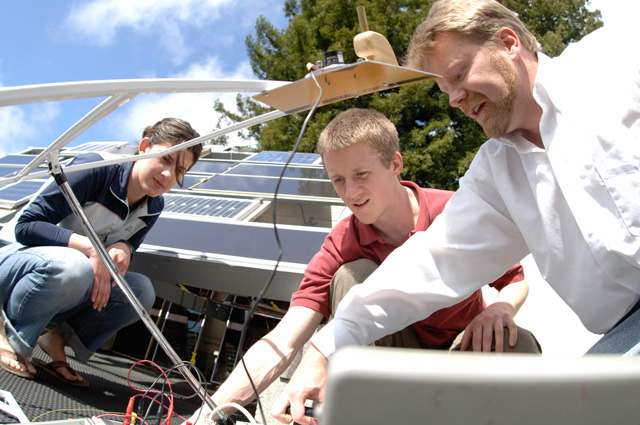
Starting in the spring of 2008, Schatz faculty Arne Jacobson and Charles Chamberlin and graduate students Colin Sheppard and Meg Harper developed a new statistical measure of residential electrical consumption that is a component of the scorecard compiled by a non-profit green watchdog, the American Council for an Energy-Efficient Economy (ACEEE). The council's third annual report, which was issued Oct. 21 and listed California as the number one state in energy efficiency, incorporated the Schatz Center's research for the first time.
Jacobson and his colleagues carried out the milestone project with about $100,000 in financing from the Natural Resources Defense Council, in partnership with the Office of Policy and International Affairs at the U.S. Department of Energy. "It's a performance-based metric, using data on different states' energy consumption," Jacobson said. "ACEEE's scorecard is policy-based, our metric is performance-based. They're different measures, but they're complementary."
The Schatz metric is a chapter in the report card and it is slated to become an ongoing contribution. The Natural Resources Defense Council proposed the measurement, HSU researchers did the technical work and now it has passed through the proof-of-concept stage.
The metric is based on total energy consumption in each state's residential sector. The data are adjusted for weather, which allows researchers to measure trends year-to-year. Each state is evaluated relative to its own baseline and over, say, a five-year period, upward and downward shifts can be plotted. Jacobson and his colleagues started with residential efficiency data because their quality is high and their inconsistencies are few. The ACEEE scorecard ranks states in six efficiency categories, including utilities, transportation and appliances.
Now the Schatz team is working with the Department of Energy to standardize its data collection so that the metric can be applied more broadly. "A lot of our work has centered on establishing that this type of metric is an effective way of tracking [efficiency]," Jacobson explained. "In conjunction with that, we've been working with the appropriate data collection agencies in the government to persuade them to invest in collecting data in a standardized way that would allow this to be done across multiple sectors. It's mainly the utilities in the states that would need to standardize the definitions."
The Environmental Protection Agency as well as the Department of Energy is strongly interested in the concept, Jacobson said, and data availability-getting the collection right-has been identified as a crucial issue in fine-tuning the performance approach. The Schatz Center and the department are examining strategies to improve collection. "We're also in the process of doing what we're calling some 'ground-truthing' analyses, where we're comparing on a state-by-state basis the ACEEE's policy-based approach with the data-based approach that we're using. Where do they link up and where are things that are unexpected?" Jacobson added.
If the nation is to meet the targets necessary to address global climate change, he said, energy efficiency is by far the least expensive approach, hence the federal government's interest in it. The challenge is that energy efficiency is largely a state responsibility and Washington does not have that much influence over it. California has been a leader in the drive for decades and if other states are to follow its model, "then we have to be able to track how well states are doing and then beyond that, create a framework of incentives for states to do well. First we have to figure out how to measure it, then figure out what policies to devise to give rewards to those who do well," he said.